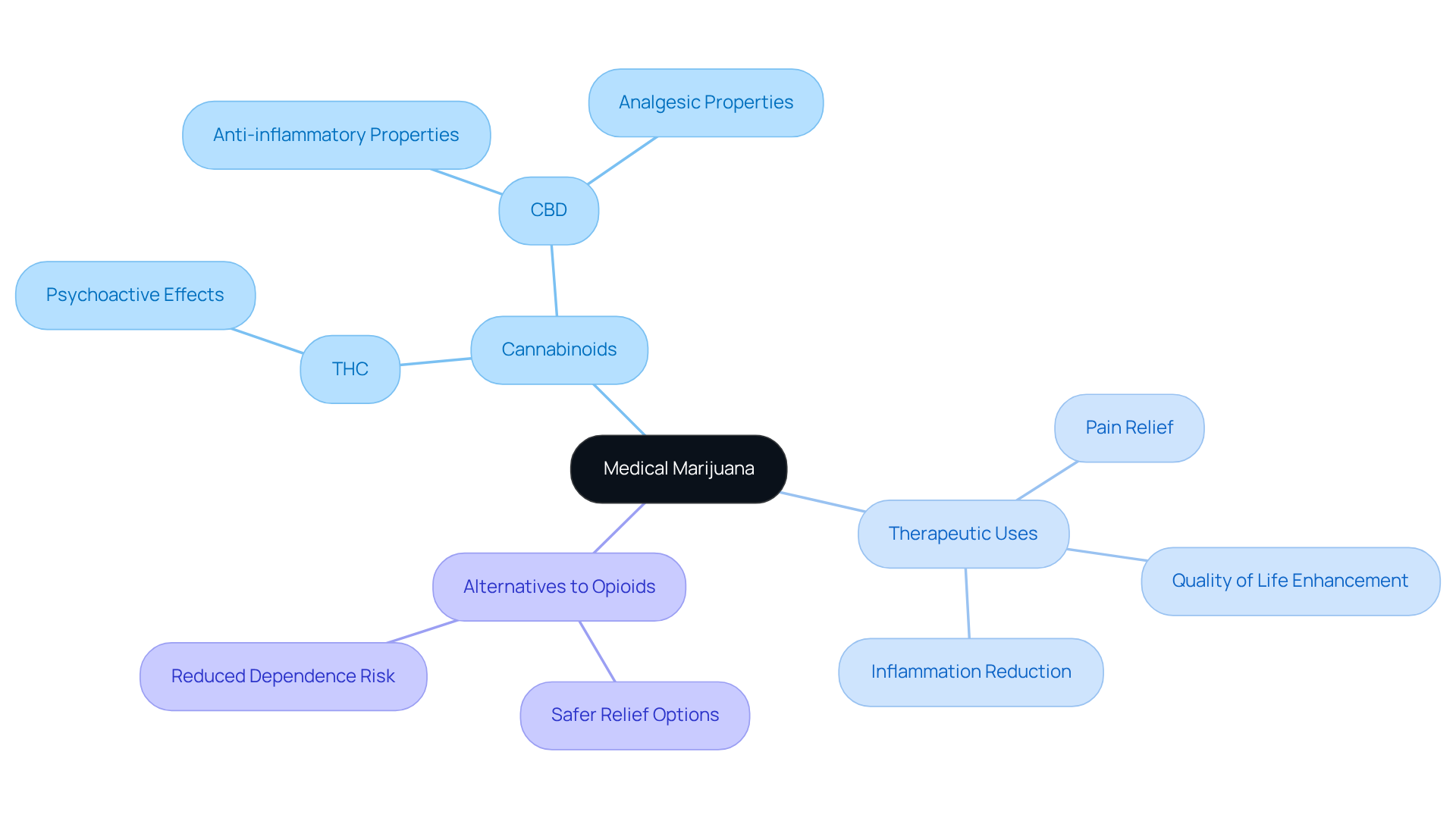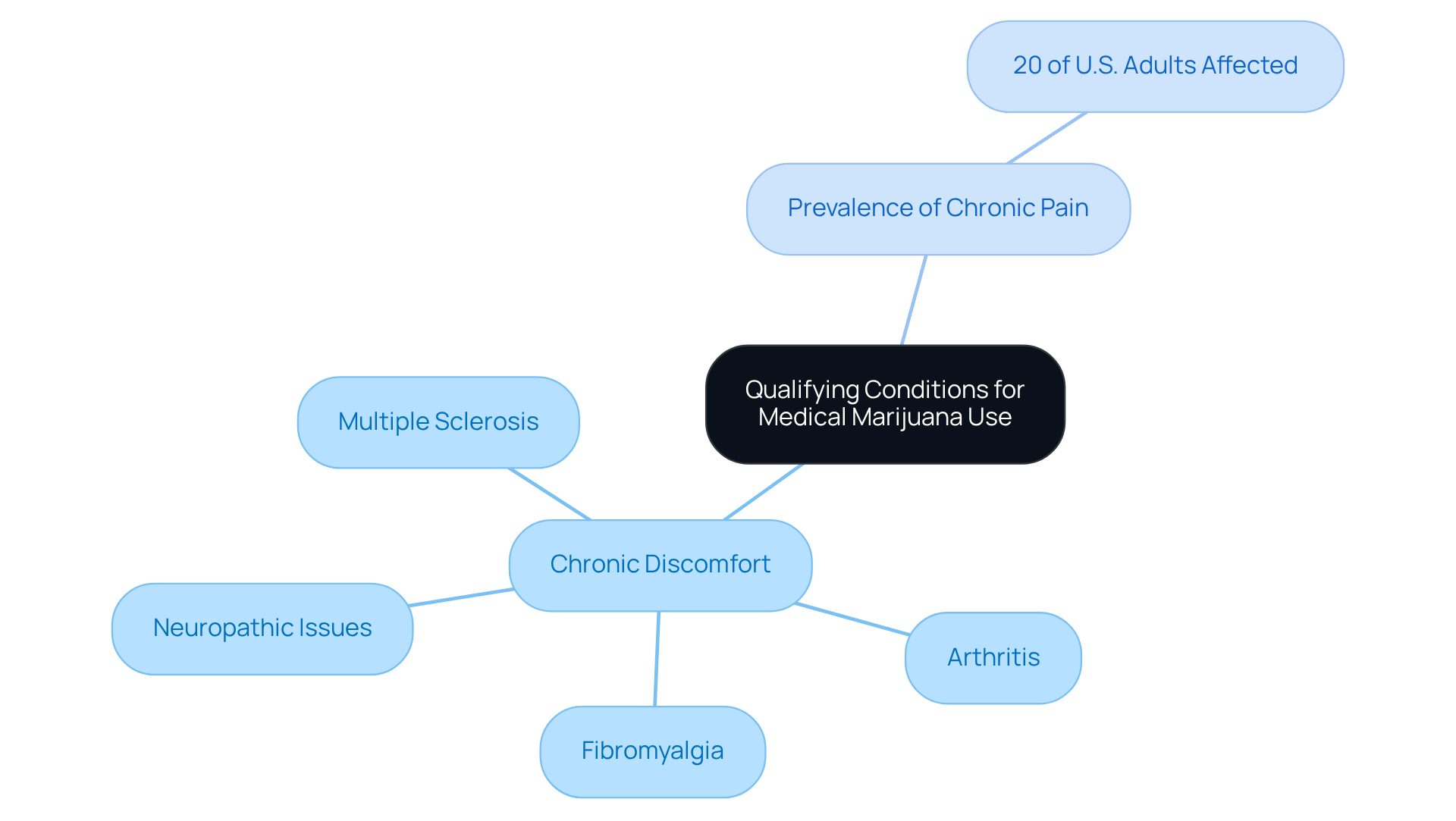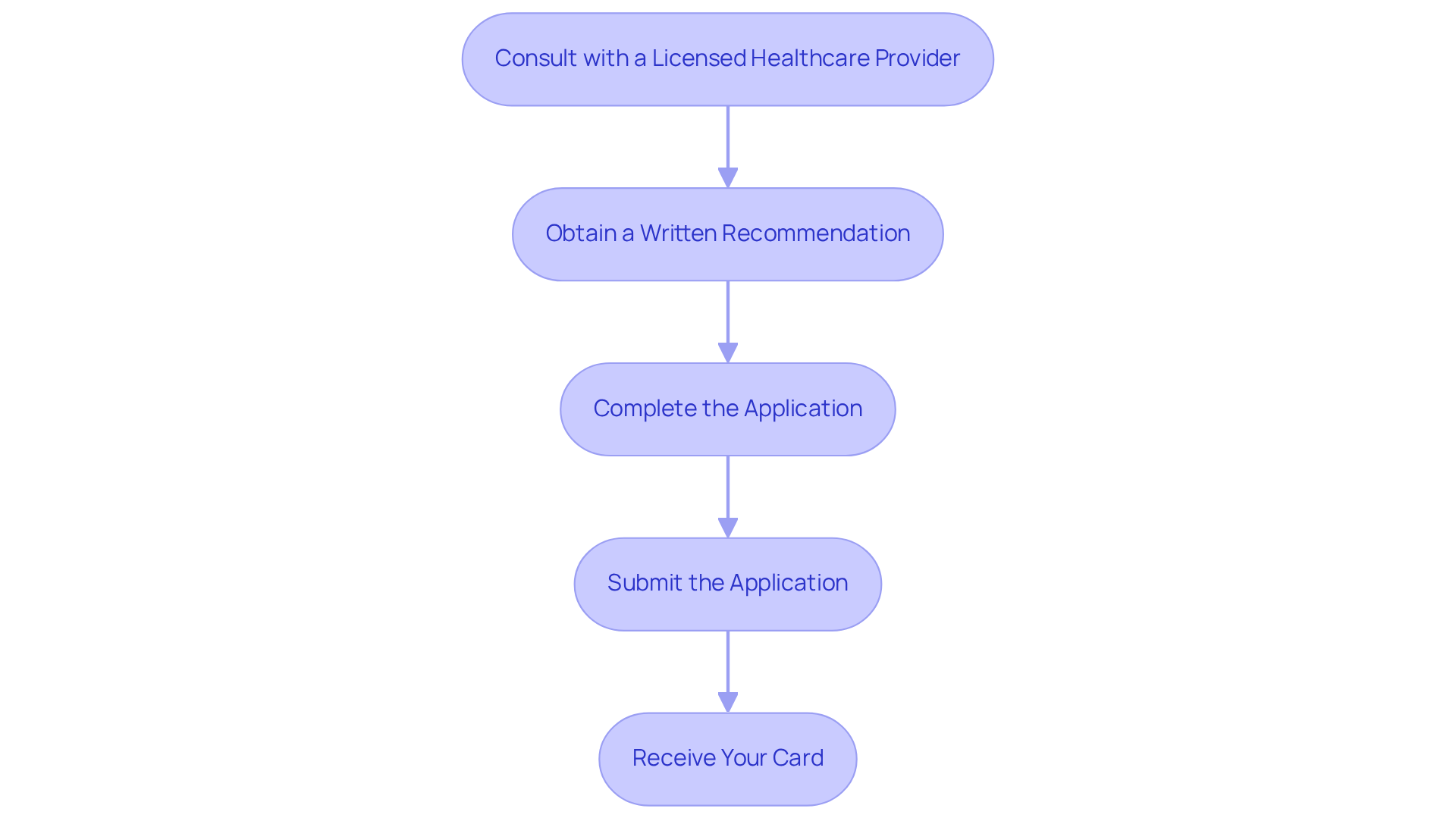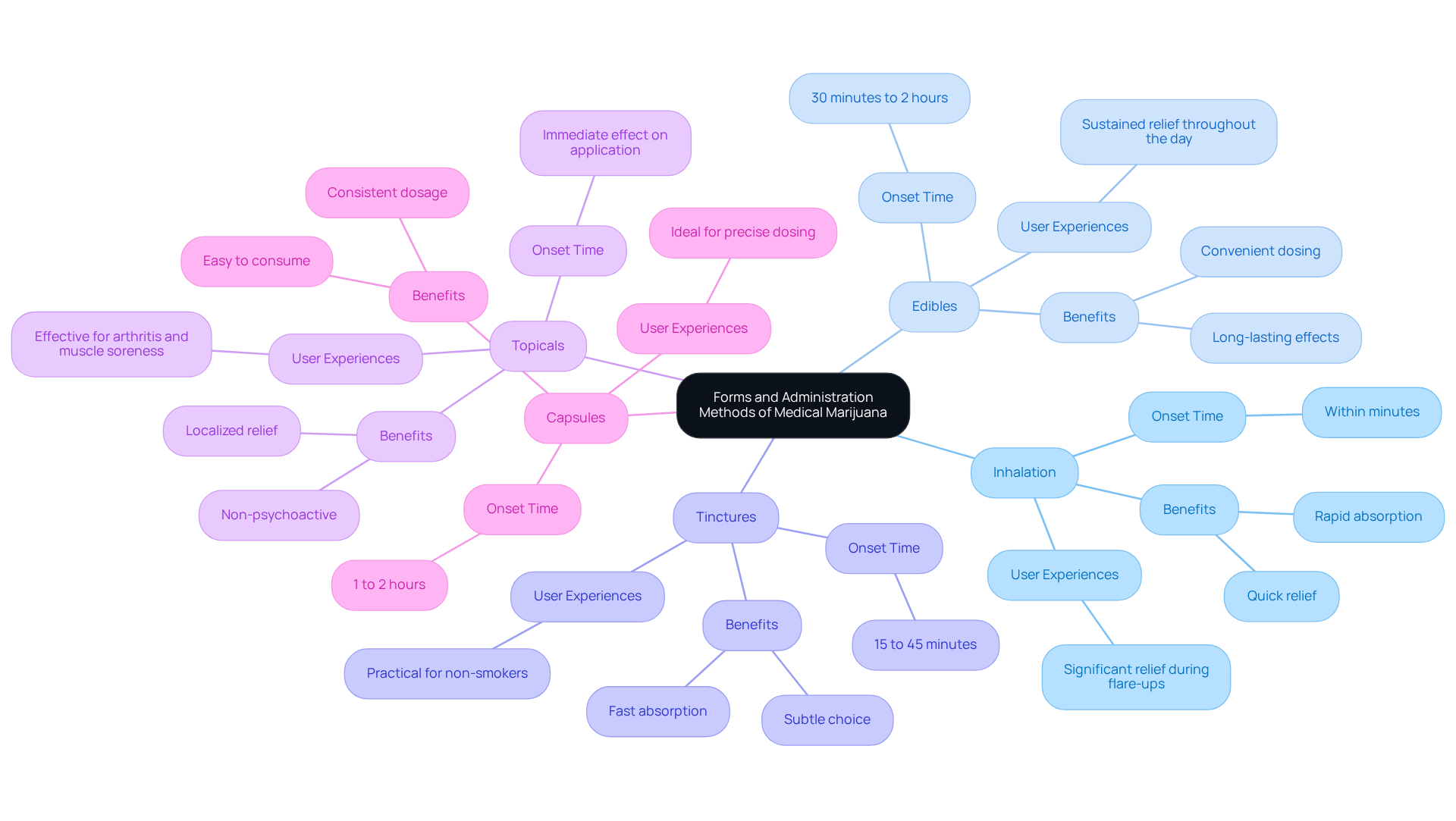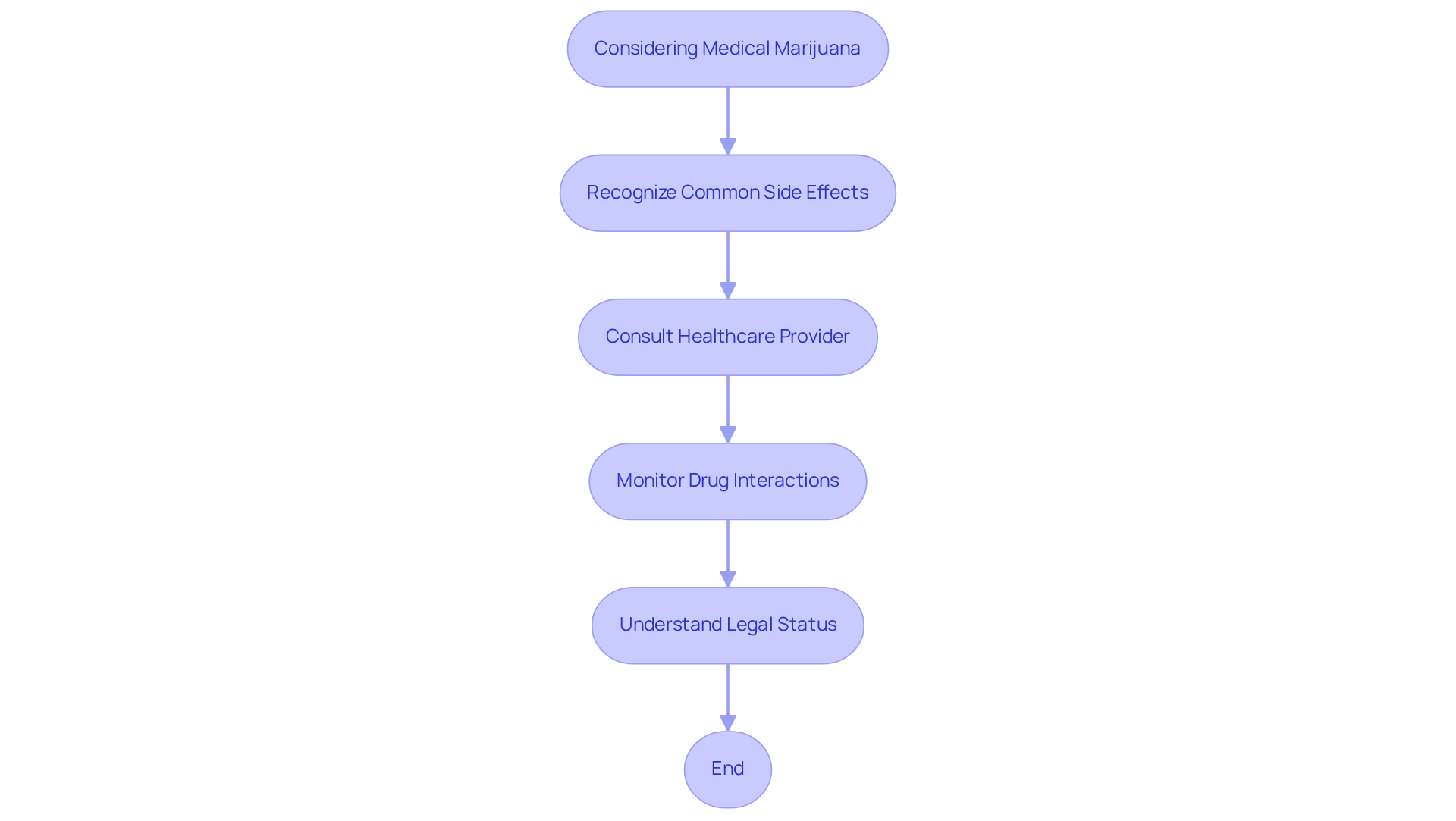5 Essential Medical Marijuana Uses for Chronic Pain Relief
by Maya Green · July 27, 2025
Discover essential medical marijuana uses for effective chronic pain relief and management.

Overview
Living with chronic pain can be incredibly challenging, and finding effective relief is often a journey filled with frustration. Medical marijuana has emerged as a compassionate option for many, utilizing cannabinoids like THC and CBD to alleviate discomfort and reduce inflammation. It’s important to remember that this approach can serve as a safer alternative to opioids, addressing chronic pain conditions such as arthritis and fibromyalgia while minimizing the risk of dependence associated with traditional pain medications.
As you explore your options, you may find that medical marijuana not only provides relief but also empowers you to regain control over your life. The evidence supporting its effectiveness is growing, and it’s heartening to see more individuals finding solace in this natural remedy. If you or someone you love is struggling with pain, consider discussing this option with a healthcare professional who understands your unique situation.
Remember, you are not alone in this journey. Seeking alternatives that resonate with you can lead to a brighter path toward healing. Embrace the possibility of relief and take the first step towards a more comfortable life.
Introduction
Navigating the complexities of chronic pain can indeed feel like a daunting journey. Many individuals find that traditional pain management options often come with significant risks and side effects, leaving them searching for alternatives. In this context, medical marijuana has emerged as a beacon of hope for many, leveraging the therapeutic potential of cannabinoids to provide relief where conventional medications may fall short.
However, with a myriad of forms, administration methods, and safety considerations, it’s important to remember that making informed choices about this alternative treatment is crucial. You may find that understanding these aspects can empower you in your journey toward relief. This article delves into five essential medical marijuana uses for chronic pain relief, offering insights that could transform your approach to managing discomfort and enhance your overall well-being.
Define Medical Marijuana and Its Therapeutic Potential
Medical marijuana uses the cannabis plant or its extracts to help address various health challenges. If you’re navigating health issues, it’s important to know that the medical marijuana uses its active compounds, called cannabinoids, for therapeutic potential. These include tetrahydrocannabinol (THC), known for its psychoactive effects, and cannabidiol (CBD), which is non-psychoactive and has shown anti-inflammatory and analgesic properties.
You may find that studies reveal the medical marijuana uses of cannabinoids, which can influence how we perceive discomfort, reduce inflammation, and enhance overall quality of life for those dealing with chronic pain conditions. It’s encouraging to know that research has suggested that medical marijuana uses, particularly cannabinoids, might provide a safer alternative to opioids, offering effective relief without the significant risk of dependence associated with conventional medications.
As you explore your options, remember that you are not alone in this journey. Many individuals are finding hope and relief through the medical marijuana uses available. Consider discussing this with your healthcare provider to see if it might be a suitable option for you. Your well-being is important, and taking steps towards understanding your choices can lead to a brighter path forward.
Identify Qualifying Conditions for Medical Marijuana Use
Qualifying conditions for medical marijuana uses vary from state to state, but it’s important to recognize that chronic discomfort is often the most common reason individuals seek this treatment. Chronic discomfort encompasses a range of conditions, including:
- Arthritis
- Fibromyalgia
- Neuropathic issues
- Multiple sclerosis
- Medical marijuana uses
Did you know that approximately 20% of U.S. adults experience chronic pain? That’s over 50 million individuals, highlighting a significant public health concern that many face daily.
If you’re considering therapeutic cannabis, it’s crucial to consult your healthcare provider. They can help you understand whether your specific condition aligns with state regulations. Some states are more inclusive, allowing any debilitating condition that significantly impacts daily life to qualify for therapeutic cannabis eligibility. Remember, a comprehensive assessment by healthcare professionals is vital. This ensures that you receive recommendations tailored to your unique needs, promoting your well-being and comfort.
It’s essential to take these steps to explore your options and find the support you deserve. You are not alone in this journey, and there are resources available to help you navigate your path toward relief.
Navigate the Process of Obtaining a Medical Marijuana Card
If you’re considering acquiring a therapeutic cannabis card, you may feel a mix of hope and uncertainty. It’s essential to know that you’re not alone in this journey. Here are the steps you typically need to follow:
-
Consult with a Licensed Healthcare Provider: Start by arranging a meeting with a physician who understands cannabis. They will take the time to evaluate your condition and help you determine if you qualify.
-
Obtain a Written Recommendation: If you are deemed eligible, your doctor will provide a written recommendation. This document is crucial for your application, and it signifies the support you have in your journey.
-
Complete the Application: Next, fill out the cannabis application specific to your state. This may require personal information, proof of residency, and the physician’s recommendation. Remember, it’s okay to ask for help if you need it.
-
Submit the Application: Once your application is complete, send it along with any required fees to the appropriate state agency. It’s important to keep a copy for your records.
-
Receive Your Card: After your application is approved, you will receive your medical cannabis card. This card will allow you to purchase cannabis from licensed dispensaries, highlighting the medical marijuana uses that can open new avenues for your health and well-being.
As you navigate these steps, remember that each part of this process is designed to support you. Take your time, and don’t hesitate to reach out for guidance when needed. You deserve the care and understanding that comes with this journey.
Explore Different Forms and Administration Methods of Medical Marijuana
Navigating the world of medical marijuana uses can be overwhelming, but it offers various forms that cater to individual needs, each with its unique benefits and varying onset times. It’s essential to choose the method that aligns with your personal requirements. Leafy DOC understands this and provides a telehealth platform that connects you with licensed healthcare professionals, ensuring you receive the guidance you deserve.
-
Inhalation is a popular choice for many, as smoking or vaporizing cannabis allows for rapid absorption into the bloodstream, delivering quick relief within minutes. This method is particularly beneficial for those experiencing intense discomfort episodes, offering prompt effects. Many individuals within the Leafy DOC community have shared their experiences of significant relief during flare-ups using inhalation.
-
On the other hand, edibles—cannabis-infused foods and beverages—offer a longer-lasting effect, typically lasting several hours. However, patience is required, as they take longer to kick in—usually between 30 minutes to 2 hours—due to the digestion process. Numerous individuals with long-term discomfort favor edibles for their sustained relief throughout the day, as highlighted in testimonials from Leafy DOC users who appreciate the convenience of dosing.
-
For those who prefer a different approach, tinctures are liquid extracts taken sublingually (under the tongue), allowing for fast absorption and effects that can be felt within 15 to 45 minutes. Tinctures present a subtle and practical choice for individuals who may not wish to smoke or consume edibles. Leafy DOC is here to guide you in selecting the right tincture to meet your needs.
-
Topicals, such as creams and balms infused with cannabis, can be directly applied to the skin, providing localized relief without psychoactive effects. This method is especially advantageous for individuals dealing with localized discomfort, like arthritis or muscle soreness. Many in the Leafy DOC community have found topicals effective for managing specific areas of discomfort.
-
Lastly, capsules offer a consistent dosage and are easy to consume, although they may take longer to take effect compared to inhalation methods, often requiring 1 to 2 hours for onset. Capsules are ideal for those seeking precise dosages and longer-lasting relief. Through Leafy DOC’s platform, you can consult with doctors regarding the best capsule choices for your discomfort management.
When considering a method of administration, reflect on your personal preferences, the nature of your discomfort, and the duration of relief you desire. Real-world experiences indicate that while some may prefer the immediacy of inhalation, others find that medical marijuana uses, such as the extended effects of edibles, are more beneficial for managing long-term discomfort. Leafy DOC’s telehealth services ensure you can easily access the information and support you need to make informed decisions about your health.
Understand Safety Considerations and Potential Side Effects
While medical marijuana uses can offer significant relief for chronic pain, it’s important to be mindful of potential side effects and safety considerations. You may experience common side effects such as:
- Dizziness
- Dry mouth
- Fatigue
- Changes in appetite
It’s essential to remember that drug interactions can occur, especially if you’re taking other medications. For example, the combination of CBD with warfarin can elevate INR levels, which means close monitoring is necessary.
I encourage you to consult with a healthcare provider to discuss any potential risks, particularly if you have pre-existing conditions like heart disease or mental health disorders. With over 106,000 individuals losing their lives to drug overdoses in 2021—three out of four involving opioids—understanding the medical marijuana uses and the associated risks of cannabis is crucial for anyone considering it as an alternative.
Additionally, be sure to familiarize yourself with the legal status of medical marijuana in your state and ensure that you are using it in compliance with local laws. A structured assessment and monitoring strategy can guide you through your cannabis journey, ensuring its safe and effective use. Remember, you’re not alone in this process, and taking informed steps can lead to a healthier path forward.
Conclusion
Medical marijuana has emerged as a compassionate alternative for individuals seeking relief from chronic pain, harnessing the therapeutic properties of cannabinoids like THC and CBD. This natural approach not only offers a potential reprieve from discomfort but also presents a safer option compared to traditional opioid medications, which carry a significant risk of dependence. As awareness and acceptance of medical cannabis continue to grow, it becomes increasingly vital to understand its applications and benefits for those navigating chronic pain management.
Throughout this exploration of medical marijuana, key insights have been highlighted, including:
- The various qualifying conditions for its use
- The process of obtaining a medical marijuana card
- The different administration methods available
From inhalation to edibles, the diverse forms of medical cannabis cater to individual preferences and needs, allowing for personalized pain relief strategies. It’s important to remember that awareness of safety considerations and potential side effects is crucial, ensuring that individuals can make informed choices about their treatment options.
Ultimately, the journey toward managing chronic pain with medical marijuana is one of empowerment and informed decision-making. Engaging in conversations with healthcare providers and utilizing available resources can pave the way for effective pain management tailored to individual circumstances. You may find that embracing this knowledge and taking proactive steps can lead to improved quality of life and a brighter path toward relief and well-being.
Frequently Asked Questions
What is medical marijuana?
Medical marijuana refers to the use of the cannabis plant or its extracts to address various health challenges, utilizing active compounds called cannabinoids for therapeutic potential.
What are the key cannabinoids found in medical marijuana?
The key cannabinoids include tetrahydrocannabinol (THC), which has psychoactive effects, and cannabidiol (CBD), which is non-psychoactive and has anti-inflammatory and analgesic properties.
How can medical marijuana help individuals with chronic pain?
Medical marijuana can influence discomfort perception, reduce inflammation, and enhance overall quality of life for those dealing with chronic pain conditions.
Is medical marijuana a safer alternative to opioids?
Research suggests that medical marijuana, particularly its cannabinoids, might provide effective relief from pain without the significant risk of dependence associated with conventional opioid medications.
What are some common qualifying conditions for medical marijuana use?
Common qualifying conditions include chronic discomfort from arthritis, fibromyalgia, neuropathic issues, and multiple sclerosis.
How prevalent is chronic pain among U.S. adults?
Approximately 20% of U.S. adults experience chronic pain, which amounts to over 50 million individuals.
Why is it important to consult a healthcare provider before using medical marijuana?
Consulting a healthcare provider is crucial to determine if your specific condition aligns with state regulations and to receive tailored recommendations that promote your well-being and comfort.
Are the qualifying conditions for medical marijuana the same in every state?
No, qualifying conditions for medical marijuana vary from state to state, with some states being more inclusive in their definitions of debilitating conditions.
Last Updated: July 26, 2025
Get Approved for Your Medical Marijuana Card in Minutes!

Get Your Medical Card
Connect with a licensed physician online in minutes
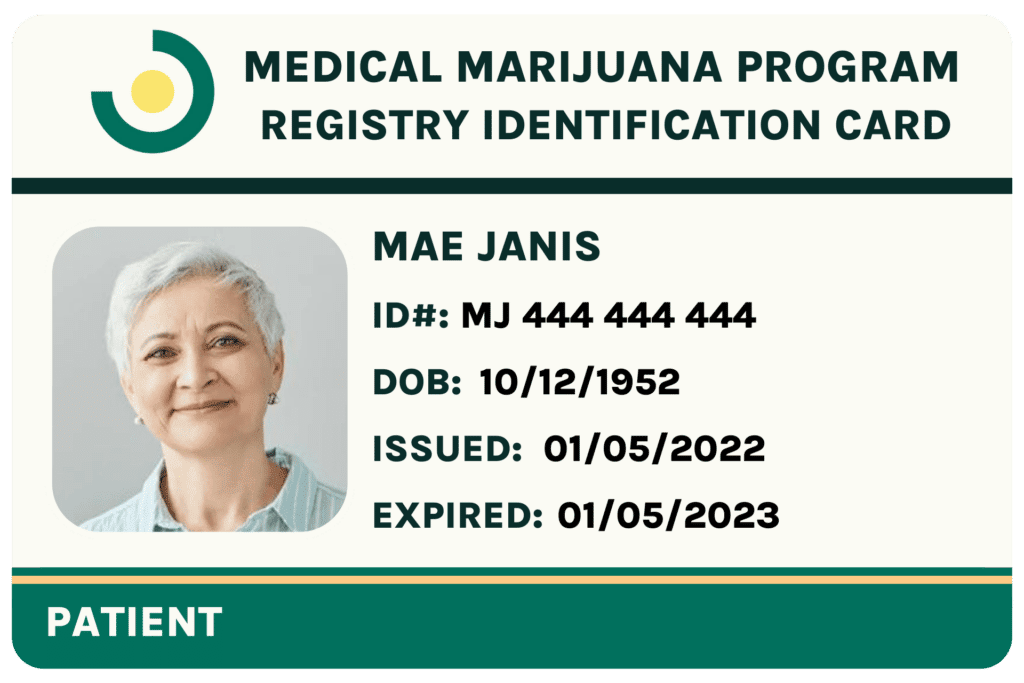
Like This Article?
Share with your friends
Table of Contents
Keep Reading
-
5 Steps to Renew Medical Marijuanas Prescription Easily
Renew your medical marijuana prescription in 5 easy steps to maintain access to your medication.
-
Unbiased Reviews Of Ohio’s Cannabis Dispensaries: Find The Best One For You
Looking for the best cannabis dispensary in Ohio? Read unbiased reviews to find the perfect one for you. Discover top strains and products catered to your needs. Click now for Ohio Cannabis Dispensary Reviews and make an informed choice today!
-
Optimize Your Fitness Routine With Cannabis
Transform Your Fitness Regimen with Cannabis: Elevate Your Workouts to New Heights. Unleash the Power of Cannabis for Optimal Performance Today!

